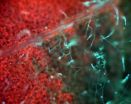(Press-News.org) SAN ANTONIO — The long-awaited results of the Adjuvant Treatment with Zoledronic Acid in Stage II/III Breast Cancer, the AZURE trial, will be presented at the 33rd Annual CTRC-AACR San Antonio Breast Cancer Symposium, held here Dec. 8-12.
"Adjuvant use of bisphosphonates like zoledronic acid is widespread among women with breast cancer, and the results of this trial will help answer many questions as well invite new ones," said Robert Coleman, M.D., professor of medical oncology at the University of Sheffield in England.
Coleman will present the results of AZURE during a press conference in room 217D of the Henry B. Gonzales Convention Center on Thursday, Dec. 9, 2010, at 12:30 p.m. CT. Results of this study are being withheld until that time.
Reporters who cannot attend the press conference in person can participate using the following call-in information:
U.S. and Canada: (888) 282-7404
International: (706) 679-5207
Access Code: 25348290
The AZURE trial included 3,360 patients from 174 centers. Coleman and colleagues randomized patients to standard therapy or standard therapy plus zoledronic acid for five years. All patients had stage II/III breast cancer.
Coleman will present the primary outcome of disease-free survival, as well as secondary outcomes and important subgroup analyses.
In addition to Coleman, the CTRC-AACR San Antonio Breast Cancer Symposium will have the following commentators on hand to answer questions during the press conference:
C. Kent Osborne, M.D., director of the Dan L. Duncan Cancer Center at the Baylor College of Medicine and symposium program chairperson;
Rowan Chlebowski, M.D., Ph.D., medical oncologist at the Los Angeles Biomedical Research Institute at Harbor-University of California, Los Angeles Medical Center; and,
Sharon Giordano, M.D., M.P.H., associate professor in the department of breast medical oncology at the University of Texas MD Anderson Cancer Center.
Michael Gnant, M.D., professor of surgery at the Medical University of Vienna, and lead investigator of the ABCSG-12 study, which evaluated zoledronic acid in premenopausal women with hormone-sensitive, early-stage breast cancer.
Gnant will discuss the results of the following abstract, which will lift embargo during this press conference.
Embargoed for Release: 12:30 p.m. CT, Dec. 9, 2010
"The Carry-Over Effect of Adjuvant Zoledronic Acid: Comparison of 48- and 62-Month Analyses of ABCSG-12 Suggests That the Benefits of Combining Zoledronic Acid with Adjuvant Endocrine Therapy Persist Long after Completion of Therapy." (SABCS Abstract #P5-11-02; December 11; 5:30-7:30 p.m. CT).
INFORMATION:
Follow the AACR on Twitter @AACR, and throughout the meeting using the hash tag #SABCS.
Recordings of the teleconferences and video interviews with researchers will posted to the AACR website throughout the meeting: http://www.aacr.org/page23506.aspx.
The mission of the CTRC-AACR San Antonio Breast Cancer Symposium is to produce a unique and comprehensive scientific meeting that encompasses the full spectrum of breast cancer research, facilitating the rapid translation of new knowledge into better care for breast cancer patients. The Cancer Therapy & Research Center (CTRC) at The University of Texas Health Science Center at San Antonio, the American Association for Cancer Research (AACR) and Baylor College of Medicine are joint sponsors of the San Antonio Breast Cancer Symposium. This collaboration utilizes the clinical strengths of the CTRC and Baylor, and the AACR's scientific prestige in basic, translational and clinical cancer research to expedite the delivery of the latest scientific advances to the clinic. The 33rd annual symposium is expected to draw nearly 9,000 participants from more than 90 countries.
SAN ANTONIO — Exemestane, an aromatase inhibitor that blocks production of estrogen, may provide another post-surgery option for postmenopausal women with hormone-receptor positive, early-stage breast cancer.
In the first head-to-head adjuvant clinical trial comparing two aromatase inhibitors, anastrozole and exemestane, the drugs resulted in similar survival rates and prevention of breast cancer recurrences. Some differences in the side effect profile were seen, including a potential difference in the risk of developing osteoporosis.
Paul E. Goss, M.D., Ph.D., professor ...
Scientists have sequenced the genome of a major fungal disease that affects barley and other cereal crops, a breakthrough that could lead to significant advances in our understanding of how plant diseases evolve. The research, published today in the journal Science, suggests that parasites within the genome of the fungus help the disease to adapt and overcome the plant's defences.
The study could help with the development of new agricultural techniques for protecting cereal crops from infection. Barley grains are the basis of many staple foods, and also central to the ...
New research reveals that the abundance of so-called highly siderophile, or metal-loving, elements like gold and platinum found in the mantles of Earth, the Moon and Mars were delivered by massive impactors during the final phase of planet formation over 4.5 billion years ago. The predicted sizes of the projectiles, which hit within tens of millions of years of the giant impact that produced our Moon, are consistent with current planet formation models as well as physical evidence such as the size distributions of asteroids and ancient Martian impact scars. They predict ...
Norwich scientists are on the trail of some of the most economically damaging organisms that infect crops worldwide. Their latest targets are the parasitic water fungus that causes powdery mildew and the water molds that cause late blight in potatoes and tomatoes and downy mildew in cruciferous vegetables and other crops.
"We have been studying the late blight pathogen for a while," said Professor Sophien Kamoun, head of the Sainsbury Laboratory on the Norwich Research Park. "In separate research we are trialling plant genes that mediate blight resistance, while in this ...
A team of scientists led by Melissa Rolls, an assistant professor of biochemistry and molecular biology at Penn State University, has peered inside neurons to discover an unexpected process that is required for regeneration after severe neuron injury. The process was discovered during Rolls's studies aimed at deciphering the inner workings of dendrites -- the part of the neuron that receives information from other cells and from the outside world. The research will be published in the print edition of the scientific journal Current Biology on 21 December 2010.
"We already ...
PITTSBURGH—If you're looking to lose weight, it's okay to think about eating your favorite candy bar. In fact, go ahead and imagine devouring every last bite — all in the name of your diet.
A new study by researchers at Carnegie Mellon University, published in Science, shows that when you imagine eating a certain food, it reduces your actual consumption of that food. This landmark discovery changes the decades-old assumption that thinking about something desirable increases cravings for it and its consumption.
Drawing on research that shows that perception and mental ...
An international team of scientists, which includes researchers from Virginia Tech, has cracked the genetic code of a plant pathogen that causes downy mildew disease. Downy mildews are a widespread class of destructive diseases that cause major losses to crops as diverse as maize, grapes, and lettuce. The paper describing the genome sequence of the downy mildew pathogen Hyaloperonospora arabidopsidis, which attacks the widely studied model plant Arabidopsis thaliana, is the cover story of this week's edition of the journal Science.
In the paper, the sequence of H. arabidopsidis ...
Doctors often ask kidney disease patients on dialysis to limit the amount of phosphate they consume in their diets, but this does not help prolong their lives, according to a study appearing in an upcoming issue of the Clinical Journal of the American Society Nephrology (CJASN). The results even suggest that prescribing low phosphate diets may increase dialysis patients' risk of premature death.
Blood phosphate levels are often high in patients with kidney disease, and dialysis treatments cannot effectively remove all of the dietary phosphate that a person normally consumes. ...
Researchers have long known that the devastating disease called Duchenne muscular dystrophy (DMD) is caused by a single mutation in a gene called dystrophin. The protein encoded by that gene is critical for the integrity of muscle; without it, they are easily damaged. But new findings in mice reported online in the journal Cell on December 9th by researchers at Stanford suggest that disease symptoms, including progressive muscle weakening leading to respiratory failure, only set in when skeletal muscle stem cells can no longer keep up with the needed repairs.
"This is ...
STANFORD, Calif. — For years, scientists have tried to understand why children with Duchenne muscular dystrophy experience severe muscle wasting and eventual death. After all, laboratory mice with the same mutation that causes the disease in humans display only a slight weakness. Now research by scientists at the Stanford University School of Medicine, and a new animal model of the disease they developed, points a finger squarely at the inability of human muscle stem cells to keep up with the ongoing damage caused by the disorder.
"Patients with muscular dystrophy experience ...


